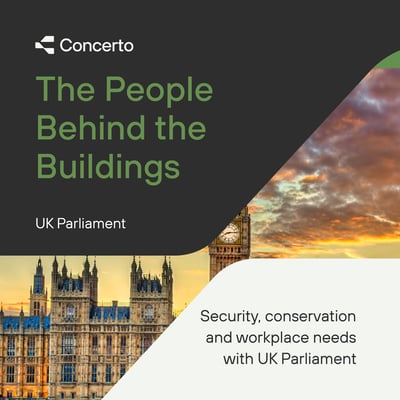
People behind the building: UK Parliament
Podcast summary: Securing history, managing the parliament estate
Overview
This episode of “People Behind the Buildings” takes listeners deep into the operational, technical and strategic challenges of managing one of the UK's most iconic estates: the Palace of Westminster. From physical security and master planning to conservation and workspace modernisation, the discussion reveals how a Grade I listed building, which also houses active government functions, is kept resilient, secure and future-ready.
Key themes and highlights
The unique nature of the parliamentary estate
- Over 1 million annual visitors, a working government seat and a world-famous heritage site, making Parliament both complex and high-profile.
- The estate includes modern leased buildings as well as historic structures like the Palace itself.
- Parliament's commitment to openness and access shapes how security and infrastructure are designed.
Balancing security and heritage
- Catherine Hallett emphasised that security is foundational but must align with the democratic and public-facing nature of Parliament.
- There's a strong culture of interdisciplinary collaboration between security, maintenance, conservation and operational teams.
- Projects are delivered under a “no surprises” approach built on shared purpose and mutual respect.
Asset management and maintenance
- Parliament has implemented rigorous asset surveys and data-led prioritisation frameworks.
- Maintenance planning balances urgent system upgrades with long-term capital investment and conservation.
- A focus on planned preventative maintenance reduces failure risk in critical infrastructure like M&E and fabric elements.
Smart workspaces and flexibility
- New workplace standards (e.g. WELL rating, post-occupancy surveys) are applied, especially in modern leasehold buildings.
- Inside heritage buildings, flexible design is more constrained but being integrated where possible (e.g. Northern Estate project).
- Parliament faces the same evolving demands as any modern organisation: hybrid work, quiet spaces, collaboration zones.
Digital and data tools
- Utilisation monitoring systems and capacity planning software are being deployed to make smarter decisions on estate-wide space planning and lease renewals.
- These tools help Parliament understand supply and demand across its estate, supporting efficient portfolio management.
Recent successes
- The Elizabeth Tower refurbishment (housing Big Ben) was a flagship project that blended precision conservation with sustainability and accessibility improvements.
- A full refurbishment of Norman Shaw North is underway, blending conservation with modern workplace principles.
Sustainability and social value
- Parliament targets:
- Net Zero (Scopes 1–3) by 2050
- 50% energy reduction vs. 2010 levels
- Social value is embedded in major projects through KPIs focused on apprenticeships, employment and inclusion.
- A holistic infrastructure strategy underpins both operational needs and environmental commitments.
Learning from others
-
Parliament collaborates closely with other UK departments and global legislative estates to share best practices in security, conservation, and operations.
Looking forward
- Major upcoming projects include:
- The Victoria Tower renewal (House of Lords)
- Further upgrades to Parliament's M&E systems
- Completion of the Norman Shaw North redevelopment
- Collaboration, across Whitehall and with local authorities, is set to be a transformative enabler.
Final thoughts
This episode is a masterclass in managing heritage within a modern context. Catherine and Chris highlight how Parliament's estate isn't just about bricks and mortar; it's about democracy, public trust and the delicate choreography of innovation and conservation.
The People Behind the Buildings
The new podcast on the block, for all the estate and property geeks to listen to on their lunch break.


